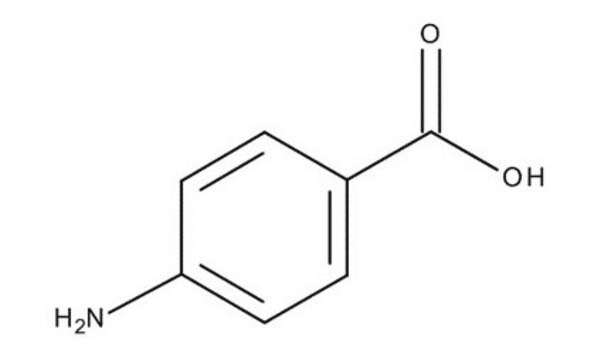100536
4-Aminobenzoic acid
99%, for peptide synthesis, ReagentPlus®
Sinónimos:
PABA, Vitamin Bx, Vitamin H1
About This Item
Productos recomendados
product name
4-Aminobenzoic acid, ReagentPlus®, 99%
Nivel de calidad
Línea del producto
ReagentPlus®
Análisis
99%
formulario
solid
idoneidad de la reacción
reaction type: solution phase peptide synthesis
mp
187-189 °C (lit.)
solubilidad
95% ethanol: soluble 5%, clear to slightly hazy, colorless to yellow
densidad
1.374 g/mL at 25 °C (lit.)
aplicaciones
peptide synthesis
cadena SMILES
Nc1ccc(cc1)C(O)=O
InChI
1S/C7H7NO2/c8-6-3-1-5(2-4-6)7(9)10/h1-4H,8H2,(H,9,10)
Clave InChI
ALYNCZNDIQEVRV-UHFFFAOYSA-N
¿Está buscando productos similares? Visita Guía de comparación de productos
Categorías relacionadas
Descripción general
Aplicación
- Covalent modification of glassy carbon electrode.
- Synthesis of 1,4-(2-chlorobenzylidene)aminobenzoic acid (Schiff base).
- Spectrophotometric determination of the trace amounts of dopamine, methyldopa and levodopa.
- Synthesis of 1:1 proton-transfer compound with 5-sulfosalicylic acid.
Información legal
Frases de peligro
Consejos de prudencia
Clasificaciones de peligro
Aquatic Chronic 3
Código de clase de almacenamiento
11 - Combustible Solids
Clase de riesgo para el agua (WGK)
WGK 2
Punto de inflamabilidad (°F)
339.8 °F - closed cup
Punto de inflamabilidad (°C)
171 °C - closed cup
Equipo de protección personal
dust mask type N95 (US), Eyeshields, Faceshields, Gloves
Certificados de análisis (COA)
Busque Certificados de análisis (COA) introduciendo el número de lote del producto. Los números de lote se encuentran en la etiqueta del producto después de las palabras «Lot» o «Batch»
¿Ya tiene este producto?
Encuentre la documentación para los productos que ha comprado recientemente en la Biblioteca de documentos.
Los clientes también vieron
Nuestro equipo de científicos tiene experiencia en todas las áreas de investigación: Ciencias de la vida, Ciencia de los materiales, Síntesis química, Cromatografía, Analítica y muchas otras.
Póngase en contacto con el Servicio técnico









